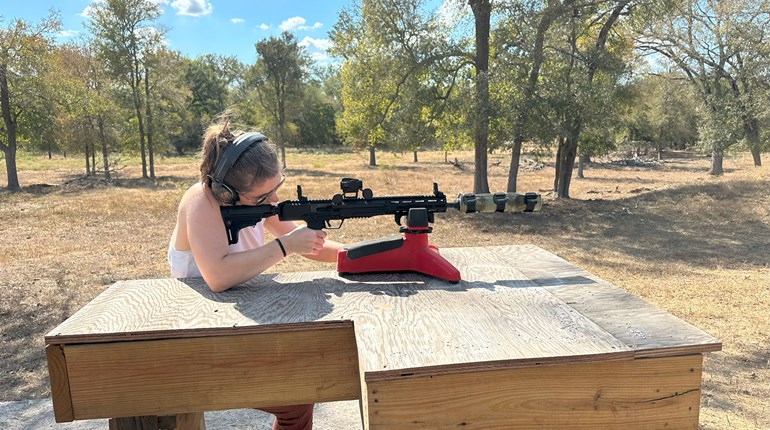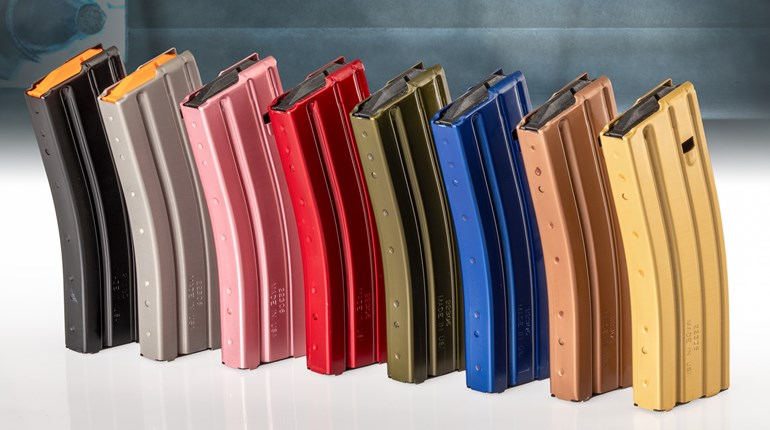
When a high- or over-pressure load is fired in a bolt-action rifle, cartridge brass flows into the ejector recess. The result is a bright mark on the cartridge-case head.
With CHS, the marks come from the ejector and extractor cutouts in the bolt face. It can be an indication of high pressure, that your rifle is not timed for the load you're shooting, or both. When a cartridge is fired in an AR, the case expands and fuses itself to the chamber until pressure drops and it springs back to near-unfired size. As the bullet passes down the barrel, it is followed by gas pressure. When the bullet passes the gas port, gas vents into the port where it is diverted to the gas key on the bolt carrier. Pressure remains high and gases are diverted until the bullet exits the barrel.
The time it takes the bullet to travel from gas port to muzzle exit is called "dwell time." Carbine- and rifle-length barrels have different length gas tubes to optimize dwell time. If too much pressure passes through the gas tube, or if the dwell time is too long, the bolt carrier starts rearward travel before the case lets go of the chamber. As gas forces the bolt carrier back, the bolt begins to rotate and move forward in the bolt carrier while the cartridge case is still under pressure and being pushed back against the bolt face. This premature rotation causes CHS. In essence, the edges of the ejector and extractor cutouts in the bolt face scrape the hot and malleable case head, creating bright marks and even burrs. In a perfect world, the bolt lugs won't start to unlock (rotate) until the bullet has left the muzzle and the case has released its hold inside the chamber.
What causes excessive dwell time? Often it's when pressures remain similar, but bullet weight is increased. When I was testing a DPMS in .308 Win. and switched from 150-grain to 180-grain factory loads, minimal CHS appeared. The slower velocity increased dwell time, causing the bolt carrier to move too soon. Minimal CHS can be a sign of high pressure, but more than likely, it indicates a timing issue—certain loads can cause the action to begin working too soon.
Because of their different pressure curves, different powders can cause CHS. I was loading .30 Rem. AR with Ramshot X-Terminator powder and 110-grain bullets. When it reached a muzzle velocity of 2,860 fps, CHS appeared. I switched to Alliant Reloader 10x and achieved the same velocity with no CHS. Then, I tried Hodgdon's H322 and pushed the 110-grain bullet to more than 3,000 fps with no CHS. All these powders have similar burn rates.
If you're seeing moderate to excessive CHS, it could be an ammo problem, a gun problem or both. But is it serious? Barring another sign of high pressure, such as excessive velocities for your barrel length and failures to feed, minimal CHS is probably not dangerous. Keep in mind, softer brass used by some manufacturers can exaggerate CHS. It's fairly common for many AR-15s and AR-10s to show minimal CHS with some pressure-safe loads.
A blown primer is generally considered a true sign of high pressure, but according to Nosler, it's not always the case with an AR. In severe cases of improper timing, the same circumstances that can cause CHS allow the primer cup to move rearward in the primer pocket, compromising the seal. The primer doesn't fall out until the case is ejected, and usually ends up in the trigger housing. A blown primer may not be a true indication of high pressure, but it is a definite sign of a problem that needs to be addressed. I treat a blown primer as a sign of high pressure and suggest you do the same.
CHS can randomly appear because peak pressure and velocity can vary a great deal between rounds out of the same lot—as much as 4,000 psi and more than 100 fps. This is a good reason to select loads that produce consistent velocities.
Excessive CHS can mar case heads so badly they won't fit into the shell holder when handloading. Back the powder charge down or switch powders, maybe even primers.
Another way to correct CHS is to alter the AR's timing. Switch to a heavier buffer spring, weight the buffer or install an adjustable gas block—or any combination thereof. However, don't assume that because certain loads show no case-head swipe in one AR, they will perform the same in another. The length/size of the gas tube and the size of the gas port can be different. Buffer spring strength and buffer weight can vary, too.
When I see anything beyond minimal CHS with any of my handloads, I fix the problem by fixing the load. With a stock rifle showing moderate to excessive case-head swipe with factory ammo loaded with common, mid-range bullet weights, send it to the manufacturer and let it correct the issue. For guns you've built, you'll have to sort it out on your own.
I talked with a lot of experts and some of the answers were conflicting, but the information here represents the general consensus. If you're seeing moderate to excessive case-head swipe, getting the timing right can fix the problem.




































